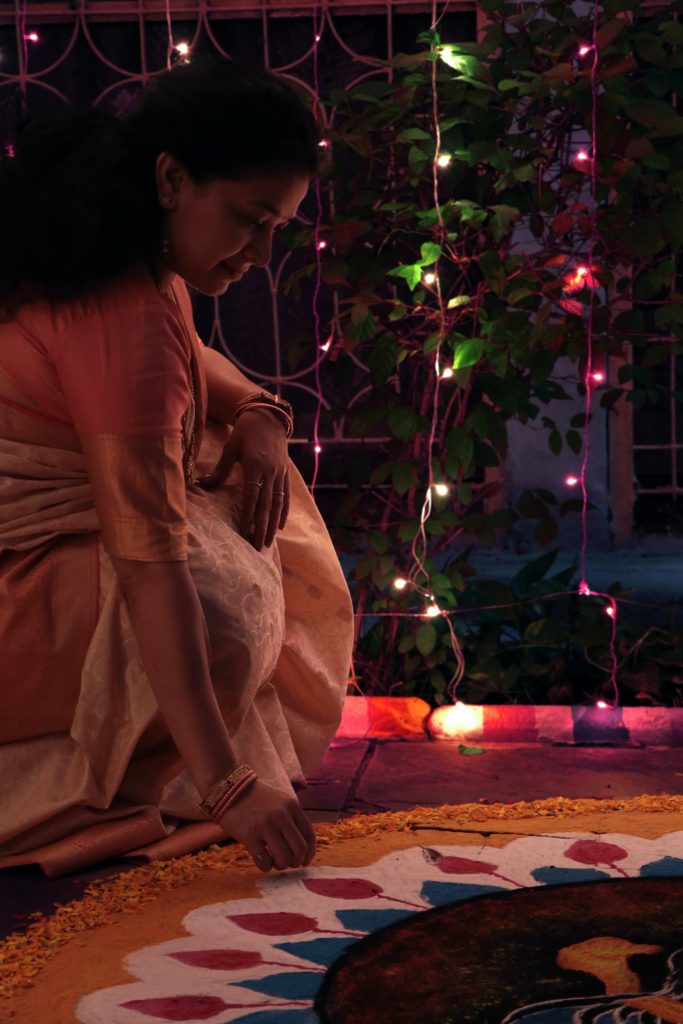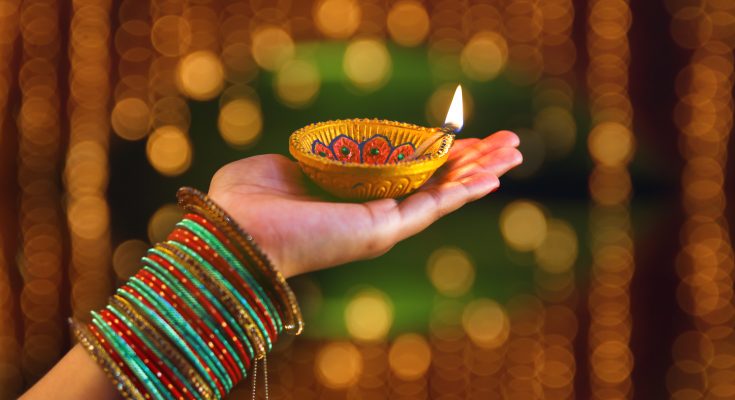Table of Contents
Short Diwali Essay in 150-200 words
Diwali- The Bright Festival of Lights
Diwali is a famous festival celebrated in India and by Hindus around the world. It’s often called the ‘Festival of Lights’ because people light up their houses with small lamps called ‘diyas’. The festival is all about the victory of good over bad and light over darkness.
The main story behind Diwali is from a book called the Ramayana. It celebrates the return of Lord Rama to his city after defeating a demon king named Ravana. To welcome him back, everyone lit up their homes.
Getting ready for Diwali means cleaning houses, shopping for new things, and making tasty sweets. On Diwali night, families come together to pray, especially to the goddess of wealth, Lakshmi. They also draw colourful designs called ‘rangoli’ on the ground and enjoy fireworks in the sky.
Today, Diwali is a time for family and friends to come together, share gifts, and have fun. It also reminds us to always choose good over bad. But, we should be careful with fireworks because they can harm our environment.
In short, Diwali is a happy festival that spreads joy, brings families closer, and teaches us good values.
Diwali Essay in 300 words

Diwali Essay- The Luminance of India’s Grandest Festival
Diwali, often hailed as the “Festival of Lights”, is not just a celebration but a phenomenon that binds the intricate fabric of India’s diverse populace. Rooted deeply in the nation’s history, Diwali transcends religious boundaries and has grown to represent the victory of light over darkness, knowledge over ignorance.
Historically, the significance of Diwali stems from the ancient Hindu epic, the Ramayana. It marks the day when Lord Rama, after 14 years of exile, returned to Ayodhya with Sita and Lakshman, after vanquishing the demon-king Ravana. In his honour, the inhabitants of Ayodhya illuminated the city with countless lamps, a practice that has been emulated for millennia.
However, Diwali’s importance is not limited to Hinduism alone. Jains commemorate it as the day Lord Mahavira achieved Nirvana. For Sikhs, Diwali holds importance as the day Guru Hargobind Ji was freed from imprisonment. Buddhists of the Newar community celebrate it, marking the conversion of Emperor Ashoka to Buddhism.
A unique aspect of Diwali is its harmonious integration of multiple customs across regions. While North India celebrates Rama’s return, the South rejoices over the defeat of the demon Narakasura by Lord Krishna. Western India, particularly Gujarat, associates the festival with the worship of Goddess Lakshmi, the deity of wealth and prosperity.
An undeniable charm of Diwali is the array of lights – from traditional clay lamps (‘diyas’) to modern LED fixtures. This spectacle is complemented by the burst of fireworks, which despite environmental concerns, continue to be a hallmark of the celebration.
But beyond the lights and festivities, Diwali promotes a deeper introspection. It’s a time for cleaning homes and hearts, fostering relationships, and igniting the internal light of self-awareness. The delightful sweets, intricate rangoli designs, and the exchange of gifts are not just rituals but symbolise love, prosperity, and hope.
In summary, Diwali isn’t just a festival; it’s a testament to India’s age-old traditions, showcasing unity, diversity, and the eternal triumph of light over darkness. This Diwali, as we light a lamp, let’s pledge to be that beacon of hope and positivity in the world around us.
Diwali Essay in 500 words

Diwali Essay- The Luminance of India’s Age-old Tradition
Diwali, often dubbed the “Festival of Lights,” stands as an emblem of India’s multifaceted cultural heritage. Far beyond the glittering fireworks, aromatic feasts, and shimmering attires lies a profound celebration of life, history, and spirituality. With its roots steeped in ancient tales and traditions, Diwali encapsulates the very essence of India’s spiritual and cultural identity. This essay delves deeper into the intricate tapestry that is Diwali, shedding light on its significance in the Indian context.
Historical and Mythological Foundations-
Diwali’s significance is deeply interwoven with India’s rich mythological tapestry. One of the most celebrated narratives finds its origins in the Indian epic, Ramayana. Diwali marks the day when Lord Rama, accompanied by his wife Sita and brother Lakshmana, triumphantly returned to Ayodhya after a 14-year exile and after defeating the demon king, Ravana. Overwhelmed with joy, the citizens of Ayodhya illuminated the entire city with earthen lamps, setting a precedent for generations to come. This timeless tale represents the overarching theme of Diwali- the victory of light over darkness, knowledge over ignorance, and good over evil.
In another tale stemming from the Puranas, Diwali is celebrated to honour the day when Lord Krishna, another revered incarnation of Vishnu, vanquished the demon Narakasura, liberating the world from tyranny. Meanwhile, in Gujarat, a western state of India, the festival is intertwined with the veneration of Lakshmi, the goddess of wealth and prosperity, marking the dawn of a new financial year.
The Five-Day Splendor-
While many outside India recognize Diwali as a single-day festivity, it is, in reality, a grand five-day celebration, with each day holding distinct importance. The gala begins with ‘Dhanteras’, dedicated to celebrating wealth and prosperity. Following this is ‘Naraka Chaturdashi’ or ‘Choti Diwali,’ observed with a quieter reverence but similar devoutness. The zenith is the third day, Diwali itself, where homes, temples, and public spaces gleam with innumerable diyas, candles, and intricate light installations. Next is ‘Govardhan Puja’, a day dedicated to remembering Krishna’s miraculous act of lifting the Govardhan hill to protect villagers. The festivities culminate in ‘Bhai Dooj’, a day that strengthens the bond between brothers and sisters.
Socio-cultural Implications-
Diwali transcends mere ritualistic celebrations. It’s a cornerstone of India’s socio-cultural framework, marking a time when families, often scattered across the globe, converge to renew and solidify ties. Traditional activities like cleaning and renovating homes before Diwali are not just symbolic of purification but also signify a soulful renewal and the ushering in of positive energies and fresh beginnings.
Evolving Traditions and Environmental Stewardship-
However, the modern iteration of Diwali has not been without concerns. The unrestrained use of fireworks has led to significant environmental implications, including skyrocketing air pollution levels and a lingering smog that often blankets cities post-celebration. Recognizing these challenges, many individuals and communities are adopting eco-friendly practices. Sustainable materials for decorations, community-driven laser light shows instead of fireworks, and organic offerings are becoming increasingly popular, marking a conscious shift towards a more responsible celebration.
Conclusion-
Diwali, with its myriad traditions and tales, is emblematic of the spirit of India — a land where ancient practices gracefully intermingle with contemporary ideals. As the lights of Diwali illuminate corners and crevices, they also ignite hearts and minds, binding communities and generations together. The global resonance of Diwali’s core message — the indomitable spirit of light triumphing over darkness — stands as a beacon of hope, ensuring that this age-old Indian festival continues to inspire and uplift souls across the world.
Also Check – Essay on Air Pollution in India- Current Challenges and Future Strategies
Also Check – Essay on Dussehra Collection
Long Diwali Essay in 1000 – 1200 words

Diwali- A Luminous Link Across Religions and Cultures
While primarily associated with Hinduism, Diwali’s embrace extends beyond a singular religious boundary, touching the hearts and histories of several other religions and communities. The universality of light, a symbol for wisdom, hope, and the divine, finds resonance in diverse religious tales associated with Diwali. This essay delves into the multi-religious perspectives on this festival of lights.
Hinduism-
Diwali, known as Deepavali (which translates to ‘row of lamps’), carries multifaceted significance for Hindus across regions and cultures.
- Lord Rama’s Return– The most widespread narrative associated with Diwali is from the ancient Indian epic, the Ramayana. According to the text, Lord Rama, after a 14-year exile and defeating the demon king Ravana, returned to his capital, Ayodhya. The residents, in jubilation, illuminated the entire city with earthen lamps (diyas) to welcome their rightful king and to celebrate the victory of dharma (righteousness) over adharma (unrighteousness).
- Victory of Krishna over Narakasura– In southern parts of India, particularly in the states of Tamil Nadu, Karnataka, and Andhra Pradesh, Diwali is associated with another legend. Here, it’s believed that Lord Krishna, an avatar of Vishnu, defeated the demon Narakasura, freeing 16,000 captive princesses. The subsequent day, known as Amavasya, is celebrated as the main Diwali day, marking the victory of light over darkness.
- Vamana and King Bali- In certain western parts of India, especially Kerala, Diwali commemorates the Vamana avatar of Lord Vishnu, where he subdued King Bali. Though a benevolent and generous king, Bali’s growing realm posed a threat to the celestial deities. Vamana, taking the form of a dwarf Brahmin, tricked Bali into granting him as much land as he could cover in three steps. Vamana then expanded to cover Earth and the heavens in two steps. Out of respect, Bali offered his own head for the third step, pushing him into the netherworld. However, Bali’s devotion impressed Vishnu, who granted him permission to visit his subjects once a year, which is commemorated as the Onam festival in Kerala, and not Diwali.
Jainism-
Diwali holds a special, solemn significance for the Jain community.
- Nirvana of Lord Mahavira– On the night of Diwali, it’s believed that Lord Mahavira, the 24th Tirthankara of Jainism, achieved moksha (liberation from the cycle of birth and death) in 527 BCE. His nirvana brought an end to his earthly journey, freeing his soul from all karma and thus achieving the highest form of bliss.
- Lighting of Lamps- The lamps lit during Diwali by Jains represent the knowledge Lord Mahavira imparted, illuminating the path to enlightenment and liberation. On this day, the Jain community engages in prayers, meditation, and reflection on Lord Mahavira’s teachings, emphasising non-violence, truth, and asceticism.
- Gyan Panchami– Five days after Diwali, Jains observe Gyan Panchami, a day dedicated to acquiring knowledge. It underscores the Jain community’s respect for knowledge and learning, reinforcing the teachings of Lord Mahavira.
Sikhism-
- Guru Hargobind Ji’s Release- Diwali holds special significance for Sikhs because it marks the release of the sixth Sikh Guru, Guru Hargobind Ji, from the Gwalior Fort in 1619. The Mughal Emperor Jahangir had imprisoned him, possibly due to the Guru’s increasing influence in the region and the perceived threat to the Mughal authority. Along with the Guru, 52 Hindu kings were also detained.
- Bandi Chhor Divas– When Jahangir decided to release Guru Hargobind Ji, the Guru insisted that the 52 kings be released with him. The Emperor set a condition- whoever could hold onto the Guru’s cloak tail would be allowed to leave the prison. Ingeniously, Guru Hargobind Ji had a cloak made with 52 tassels, allowing all the kings to hold onto one. This day of release is celebrated as “Bandi Chhor Divas” (The Day of Liberation) by Sikhs, coinciding with Diwali.
- Illumination of Golden Temple- On the Guru’s return to Amritsar, the Sikhs lit up the city in a grand celebration of his release. The tradition continues to this day, with the Golden Temple spectacularly illuminated, and fireworks lighting up the sky. For Sikhs, the lights symbolise the light of the Guru’s teachings, which dispel the darkness of ignorance and oppression.
Buddhism (Newar Buddhists of Nepal)-
- Ashoka’s Conversion– For Newar Buddhists in the Kathmandu Valley of Nepal, Diwali marks the celebration of the Indian Emperor Ashoka’s conversion to Buddhism. Ashoka, originally known for his conquests and the Kalinga War, was deeply affected by the vast bloodshed and turned to Buddhism in search of solace. He subsequently became a patron of Buddhism and played a pivotal role in its spread.
- Symbolism of Lamps- During Diwali, Newar Buddhists light lamps to commemorate this conversion, symbolising the light of dharma (Buddhist teachings) that dispelled the darkness in Ashoka’s heart and mind.
- Incorporation of Diwali- While Diwali is not a traditional Buddhist festival, its themes of light over darkness and good over evil resonate with Ashoka’s transformation from a ruthless conqueror to a compassionate ruler. For Newar Buddhists, this overlap allowed for the incorporation of Diwali celebrations into their religious practices.
Interfaith Dialogue-
- Universal Themes of Diwali- The central theme of Diwali – the victory of light over darkness and good over evil – is not exclusive to one religion or culture. These are universally resonant themes that can be found in the core beliefs of many religious and philosophical traditions.
- Celebration Beyond Boundaries in Trinidad and Tobago- In Trinidad and Tobago, a nation with a significant population of East Indian descent (primarily Hindus), Diwali has transcended its religious confines. The festival has become a national event celebrated by people of various backgrounds, including Christians, Muslims, and indigenous communities. Here, Diwali promotes unity and mutual respect, with communal events often involving interfaith discussions and collaborative festivities.
- Malaysia’s Deepavali- While Diwali is called “Deepavali” in Malaysia, its essence remains true to its roots. Although a Muslim-majority nation, Malaysia recognizes Diwali as a public holiday. The festival acts as a bridge, fostering understanding between the Hindu minority and the larger Muslim, Buddhist, and Christian communities.
Modern Context-
- Diwali as a Cultural Ambassador- The Indian diaspora, spread across continents, has played a pivotal role in introducing Diwali to various corners of the globe. From the United States to Europe, local communities often participate in the festivities, using it as an opportunity to learn about Indian culture and traditions.
- Recognition by World Leaders- In recent years, several global leaders have recognized and celebrated Diwali. For instance, the White House has, over various administrations, hosted Diwali celebrations, emphasising the importance of diversity and inclusion in American society.
- London’s Trafalgar Square Celebrations- The Diwali celebrations in London are a testament to the multicultural fabric of the city. Every year, Trafalgar Square witnesses a grand celebration, complete with cultural performances, workshops, and stalls. These festivities, often attended by thousands, serve as a platform to showcase Indian culture to a wider audience.
- A Counter to Growing Intolerance- In regions experiencing religious or racial tensions, Diwali’s universal message offers a timely reminder. The emphasis on light, knowledge, and unity encourages communities to focus on commonalities rather than differences. By celebrating Diwali, communities can reinforce the ideals of mutual respect and coexistence.
Conclusion- Diwali’s luminance isn’t confined within the perimeters of Hinduism. Its radiance touches various religions, emphasising universal themes of enlightenment, joy, and triumph over adversity. In understanding and celebrating these multi-religious facets of Diwali, we move a step closer to global harmony, appreciating the interconnectedness of human experiences and beliefs.



